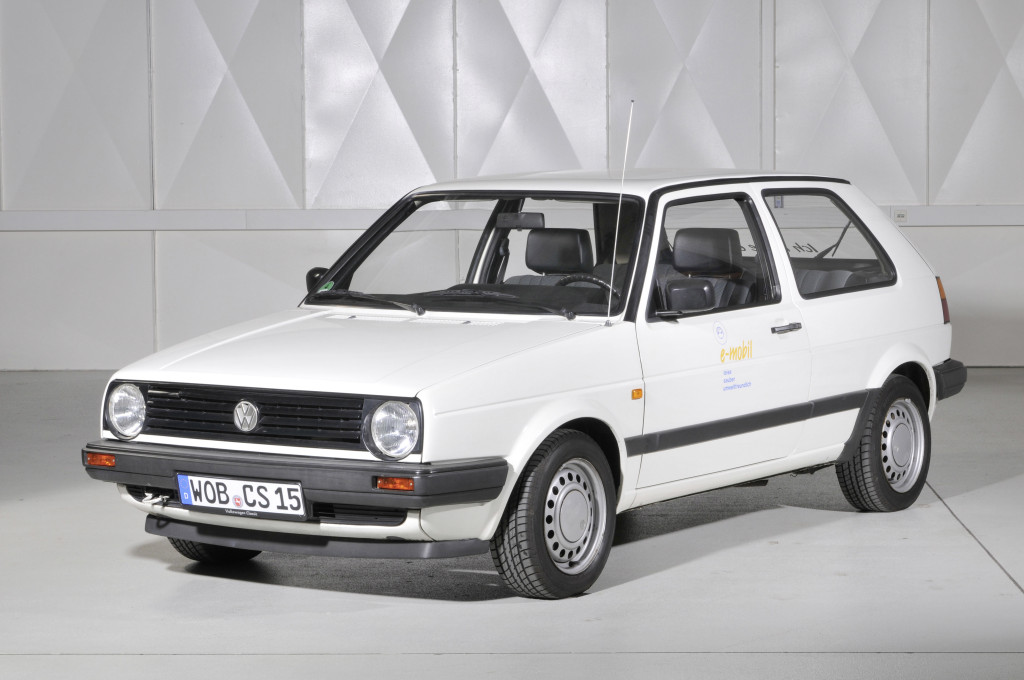With the formal nod of Volkswagen’s board on Friday, Volkswagen is embarking upon a five-year, $50 billion all-in push to develop a new generation of electric cars, plus complementary autonomous-drive technologies and mobility services.
As Volkswagen works toward a viable, global, mass-market business, and millions of vehicles built around its modular electric architecture (MEB), it faces the biggest change since moving from air-cooled rear-wheel-drive vehicles to water-cooled (primarily) front-wheel-drive ones decades ago—and arguably a bigger one.
DON’T MISS: VW e-Golf in very short supply as company prepares for ID Crozz electric car
Teased by a series of concepts including the I.D., I.D. Crozz, I.D. Buzz, and I.D. Vizzion, these production models will be different than any electric vehicles in VW’s past as they’ll no longer leave space for internal combustion engines and fuel tanks.

Volkswagen Golf 3 CityStromer
It seemed like the appropriate time to look back at some of Volkswagen’s far-earlier attempts at electric vehicles. Like those from most other major automakers, they were surprisingly modest affairs—essentially back-garage conversions produced by research-and-development teams, that would get, at best, a fleet test to see how the batteries held up.
CHECK OUT: Volkswagen details the foundation for 10 million electric vehicles
Back in the 1990s, when electric vehicles were first injected into the realm of possibility thanks to several advances, Volkswagen made no grand commitments like the General Motors EV1. Some years later, though, the curious XL1 was Volkswagen’s way of showing that diesel had a long life ahead with the addition of electrification.
Years or decades earlier, there were these:

1972 Volkswagen T2 Elektro Transporter
1972 T2 Elektro Transporter
If you didn’t think Volkswagen could make a slower Type 2 (Microbus) than it already had, it did—and it was electric. The DC motor at the rear wheels delivered just 16 kilowatts (22 horsepower). And yet the Transporter weighed 4,840 pounds—with the lead-acid batteries fitted to the van’s floor weighing 1,870 pounds—more than a Beetle of that era. VW made 120 of these.

Golf 1 Elektro
1976-1981 Volkswagen Golf 1 Elektro
VW made 20 of these Golf 1 Elektro hatchbacks (based on a car sold in the U.S. as the Rabbit). The flat, tubular, lead battery system (at 96 volts) had a 13.4-kwh capacity but turned the Rabbit into a two-seater. Top speed was 62 mph, and range was about 30 miles. One item of note is that its 15-kw (20-horsepower) DC motor weighs 176 pounds. For a modern comparison, each 147-kw (197-hp) DC permanent-magnet motor in the Jaguar I-Pace weighs just 84 pounds.

1981 Volkswagen Golf 1 CityStromer
1981 Volkswagen Golf 1 CityStromer
The CityStromer could carry four and had enough lead-acid battery capacity for a range of nearly 40 miles. VW made 25 of these, in collaboration with an electric utility, RWE, and they were used only by the company.

1984-85 Volkswagen Golf 2 CityStromer
1984-85 Volkswagen Golf 2 CityStromer
Advances included gel-electrolyte battery modules, and a claimed range of 31 miles. Power was up to 18.5 kw (25 hp), and this MkII version of the CityStromer could reach 62 mph. Volkswagen made 70 of these, some of which ended up with private individuals.

1994-1996 Volkswagen Golf 3 CityStromer
1994-1996 Volkswagen Golf 3 CityStromer
The MkIII CityStromer has 16 lead-gel battery blocks, also running at 96 volts and totaling 17.28 kilowatt-hours of capacity. It weighed about 3,300 pounds and had a range listed as 43 miles in the summer or 25 miles in the winter. Performance specs like acceleration and top speed, from the 20-kw (27-horsepower) motor, were solidly in the “don’t ask” category. Volkswagen made 120 of these.

Volkswagen Golf Blue e-Motion
2010 Golf VI Blue e-Motion
With lithium-ion cells, DC fast charging, and three different driving modes, the Blue e-Motion was a mammoth step forward in technology—and the bridge from those less-finished vehicles to the Europe-only e-Up and the current production e-Golf.













